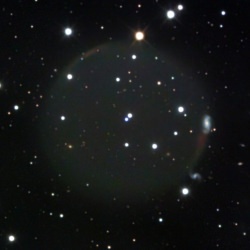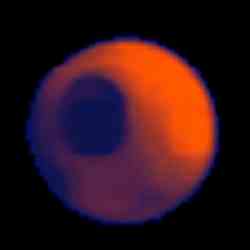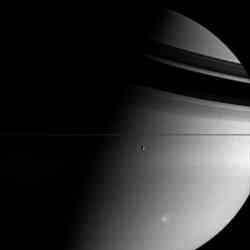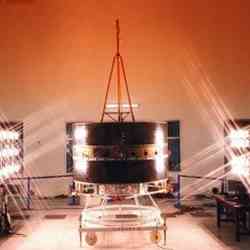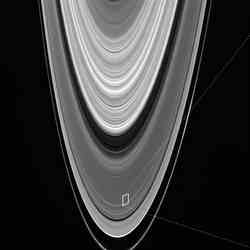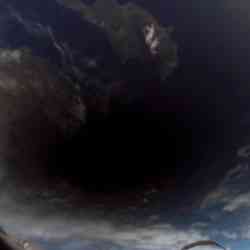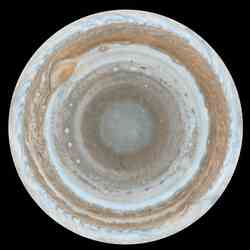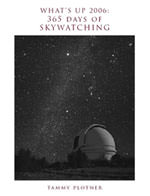
Download our free “What’s Up 2006” ebook, with entries like this for every day of the year.
|
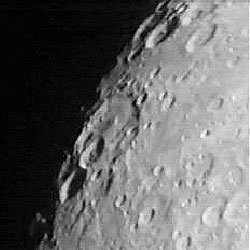
Craters Steinheil and Watt. Image credit: Tammy Plotner. Click to enlarge.
Greetings, fellow SkyWatchers! We’ll take a journey to the Moon this week as we explore some outstanding features that make our “neighbor” such a fascinating target. ‘Tis also the season for aurora and we’ll find out why. Be sure to be on watch for meteors and get out the scope to play, because….
Here’s what’s up!
Monday, April 3 – Today marks the 40th anniversary of the launch of the first lunar orbiter – Luna 10. That makes another good reason to view the Moon tonight!
Just a short distance north of the southern cusp, look for a twin pair of craters on the terminator tonight. These are Steinheil and Watt. The two are nearly identical in size an overlap each other. Steinheil, named for mathematician, physicist, optician, and astronomer Karl August von Steinheil is just bit deeper and to the north. Watt, named for my great gandfather James Watt, Scottish engineer and first man to patent the use of a telescope for surveying, will show a wee bit more detail on its floor.
Right now Earth’s magnetosphere and magnetopause are positioned correctly to interact with the Sun’s influencing interplanetary magnetic field (IMF) – and the plasma stream which flows past us as solar winds. During this time after equinox, this phenomenon leaves the door wide open for one of the most awesome signs of spring – aurora! Visit the Geophysical Institute to sign up for aurora alerts and use their tools to help locate the position of the Earth’s auroral oval.
Tuesday, April 4 – Tonight through binoculars or a telescope, let’s head toward the Moon’s southern quadrant and view Theophilus. Located on the terminator and bordered on the northern edge by Mare Nectaris and to the south by Mare Tranquillitatis, Theophilus has an average diameter of 105 km and contains a wonderful multiple-peaked center. This particular crater is unusual because the floor is parabolic. The interior may be dark, but you should see the Sun catching the summit of its huge central peak.
After the Moon sets, keep the watch for the Kappa Serpentid meteor shower. Its radiant lies near the “Northern Crown” – Corona Borealis. The fall rate is low, with an average 4 or 5 per hour.
Tonight will be the last chance for deep sky studies before the Moon dominates, so let’s take advantage. Did you know that there is a galaxy in Cancer? OK – so you did… But, did you know that the galaxy NGC 2775 has been home to 5 supernovae in the last 30 years, or that it’s one of the most unusual but otherwise perfect spiral shapes in the heavens? Then, get a scope out and start by locating Alpha Cancri and head not quite a fist’s width southeast and in line with Zeta Hydrae. NGC 2775 is a 10.3 magnitude oval of luminosity within a low power field.
Wednesday, April 5 – There’s plenty of Moon to explore tonight, so why not try locating an area where many lunar missions left their mark? Binoculars easily reveal the fully disclosed mares of Serenitatis and Tranquillitatis. Set your sites where these two vast lava plains converge. Telescopically you will see a bright “peninsula” where they meet in the west. Look for bright and small crater Pliny to the east of this point.
It is near this rather inconspicuous feature that the remains of Ranger 6 lay forever preserved after “crash-landing” on February 2nd, 1964. Unfortunately, technical errors prevented Ranger 6 from transmitting lunar pictures. Not so Ranger 8! On a very successful mission to the same basic area, NASA received 7137 “postcards from the near side of the Moon” for 23 minutes before a very hard landing. On the “softer side,” Surveyor 5 touched down near this area safely after two days of malfunctions on September 10, 1967. Incredibly, the tiny Surveyor 5 endured temperatures of up to 283 degrees F, but still spectrographically analyzed the area’s soil and also managed to televise over 18,000 frames of “home movies” from its distant lunar location.
Tonight let’s “see double.” At magnitude 2.5, Gamma Leonis – or Algieba – is second brightest member of the Leo “question mark.” Now we have a question for you. Did you know that Algieba is among the most lovely pairs in the night sky? See for yourself! Separated by less than 5 arc seconds, the primary appears ivory, while the secondary is golden. Those with smaller scopes will enjoy the beauty of the “airy disks” displayed by this pair.
Thursday, April 6 – Tonight let’s return to a now familiar lunar feature, Albategnius. A fine challenge for binoculars will be to see if you can make out its bright central peak from the darker lava-covered floor. Power up with a telescope for another challenge. Can you spot the small craters Vogel and Burnham on its southeast edge? Or Ritchey just outside its eastern wall? Look for craters Halley and Hind just between Albategnius and Hipparchus to the north. Hipparchus also holds a very detailed small crater named Horrocks on its northern wall. Shallow crater Saunder is just to its east.
Ready for another challenge? Then let’s head for Iota Leonis – just south of the triangle that makes up eastern Leo. At magnitude 4, it will be difficult to see its close 7th magnitude companion. This is known as a disparate double – a pair unevenly matched in brightness. One of the most difficult double stars in the heavens!
Friday, April 7 – Today in 1991, the Compton Gamma Ray Observatory (GRO) was deployed. Part of NASA’s Great Observatories program, the CGRO was named to honor Dr. Arthur Holly Compton – a Nobel Prize winning physicist. CGRO scanned six decades of electromagnetic radiation at energy ranges well beyond anything the eye can see. Such energies often happen in bursts as extraordinary and cataclysmic events occur in the cosmos.
Be sure to take your telescope out and have a look at the Moon tonight. One of the most sought-after and unusual features will be visible in the southern half of the Moon near the terminator – Rupes Recta! Also known as “The Straight Wall,” this 130 km (75 mile) long, 366 meter (1200 ft) high feature slopes upward with the steepest angle on the lunar surface (41 degrees). It will be a challenge under these lighting conditions, but look for triple ring of craters Ptolemy, Alphonsus, and Arzachel to guide you. The “Straight Wall” appears as a very thin line stretching across the edge of Mare Nubium.
Be on the lookout for bright streaks from the Delta Draconid meteor shower. Its radiant lies near the border with Cepheus to the east. The fall rate is quite low – around 5 meteors per hour.
Even with the Moon, let’s try for a scattered open cluster toward the west in Auriga. At magnitude 5.4, NGC 2281 should be visible as a nebulous mist in binoculars on a dark night, but you’ll need a scope and high power to darken the sky enough to see the bright members found near its core. NGC 2281 is around 1500 light years distant and 50 million years old. It can best be found by extending a line from Capella to Beta Aurigae an equal distance east to a pair of 5th magnitude stars separated by a finger width. NGC 2281 lies less than one degree southeast of the eastern member of this pair (58 Aurigae.)
Saturday, April 8 – Start your evening by revisiting crater Copernicus as it becomes visible to even the most modest of optical aids. Small binoculars will see Copernicus as a bright “ring” about midway along the lunar dividing line of light and dark called the “terminator.” Telescopes will reveal its 97 km (60 mile) expanse and 120 meter (1200 ft.) central peak to perfection. Copernicus holds special appeal as the aftermath of a huge meteoric impact! At 3800 meters deep, its walls are 22 km thick. Over the next few days, the impact ray system extending from this tremendous crater will become wonderfully apparent.
Tonight we’ll use Copernicus as a guide and look north-northwest to survey the Carpathian Mountains. The Carpathians ring the southern edge of Mare Imbrium beginning well east of the terminator. But let’s look on the dark side. Extending some 40 km beyond into the Moon’s own shadow, you can continue to see bright peaks – some reaching 2000 meters high! Tomorrow, when this area is fully revealed, you will see the Carpathians begin to disappear into the lava flow forming them. Continuing onward to Plato – on the northern shore of Mare Imbrium – look for the singular peak of Pico. Between Plato and Mons Pico you will find the many scattered peaks of the Teneriffe Mountains. It is possible that these are the remnants of much taller summits of a once precipitous range. Now the peaks rise less than 2000 meters above the surface. Time to power up! West of the Teneriffes, and very near the terminator, you will see a narrow line of mountains, very similar in size to the Alpine Valley. This is known as the Straight Range and some of its peaks reach as high as 2000 meters. Although this doesn’t sound particularly impressive, that’s over twice as tall as the Vosges Mountains in west central Europe and on average, comparable to the Appalachian Mountains of the eastern United States.
Sunday, April 9 – Tonight let’s continue our lunar mountain climbing expedition and revisit the “big picture” on the lunar surface. Tonight all of Mare Imbrium is bathed in sunlight and we can see its complete shape. Appearing as a featureless ellipse bordered by mountain ranges, let’s identify them all again. Starting at Plato and moving east to south to west you will find the Alps, the Caucasus, the Apennine and the Carpathians mountains. Look at the form closely=85doesn’t it look like it’s possible that an enormous impact created the entire area? Compare it to the younger Sinus Iridium ringed by the Juras Mountains. It may have also been formed by a much later and very similar massive impact event.
In the mood for a double star? Then let’s head west and away from the Moon. Begin your search right after skydark with El Nath – Beta Tauri. From Beta shift about two finger-widths east-northeast to identify very dim 26 Aurigae. At low power, look for an 8th magnitude companion due west of the 5.5 magnitude primary. The brighter star should give a warm yellow appearance while the fainter appears slightly more blue. This pair shares space with a third member (magnitude 11.5) – some three times further out from the primary than the closer, brighter secondary. Thanks to lunacy, small instruments will have difficulty distinguishing the C star in such bright skies.
May all your journeys be at light speed… ~Tammy Plotner. (contributing writer: Jeff Barbour).
